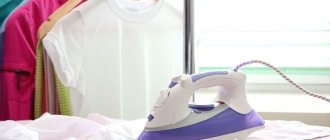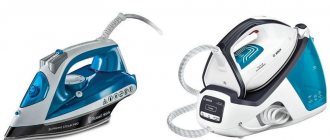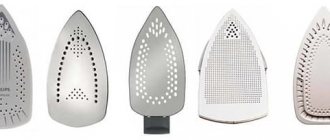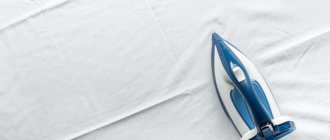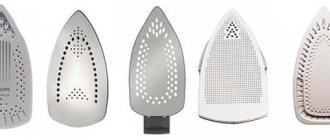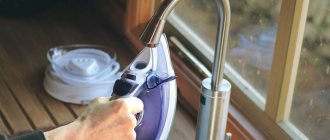Only high-quality iron water can prevent the appearance of drips and yellow spots on clothes. A liquid containing a large amount of salt and calcium impurities can damage the device and also ruin new things. Any equipment owner should know which iron water is suitable for use and which is not advisable to use.
How does a steam iron work?
It has been known since ancient times that if you iron wet items, the result will be better. Fabric fibers soaked in liquid become softer. By evaporating, moisture reduces friction between individual fibers. Previously, when ironing, they used wet gauze or a spray bottle, which was used to spray the item before ironing.
Today, a special unit has been introduced into the design of the iron - a steamer. It includes a reservoir that contains water and a device for regulating its supply to the heating element. Upon contact with a hot heating element (its temperature is about 150°C), water instantly turns into steam. But the salts contained in the water cannot turn into steam - they settle in the form of crusts on the surface of the iron. This is how scale forms.
In the instructions, manufacturers recommend using tap water to fill steamer tanks. But these are general recommendations; they are written without taking into account the specifics of water supply in different countries and regions. Not in all areas the quality of tap water allows you to avoid scale formation.
Special H2O for household appliances: advantages and disadvantages
In the household appliance departments you can purchase water for steam generators and irons.
It has a number of advantages:
- designed specifically for use in household appliances;
- properly cleaned;
- helps prevent the formation of stains on things and streaks on surfaces.
This is the best option. The disadvantages are the difficulty of purchasing in some localities and the high price.
Special flavored water for irons and steam generators is not the best choice. It has a pleasant smell that is transferred to the things being processed.
But such a liquid may contain minerals and organic matter. When water is heated, such impurities often produce stains and stains on surfaces.
The influence of liquid quality on the condition of the device
It should be remembered that the quality of the liquid is very important for the operation of the device. Using water that is not suitable for this purpose can have a detrimental effect on the operation of the iron. Thus, water with a high content of minerals and salts will inevitably lead to plaque. In addition to the fact that due to this problem, stains may appear on things during ironing, it also negatively affects the functioning of the iron. Plaque will gradually accumulate inside. Over time, he will be able to completely clog the steam supply holes and get to the parts.
In order to avoid this, preference should be given to using those water options whose quality meets established standards.
Iron manufacturers recommend using:
- distilled water;
- filtered;
- special liquid for irons.
Water from wells and wells
Do not use water from a borehole or well! This, at first glance, healthy and safe water, extracted from the earth, passes through iron ores and limestone, thereby filling with harmful and hard substances.
This water is hard due to the content of mineral salts and lime. Untreated water contains metals in large quantities: manganese, zinc, potassium and iron. In addition, it is filled with dissolved hydrogen sulfide and carbon dioxide, radon and radioactive substances.
These impurities reduce the quality of water and make the latter dangerous when used in everyday life, for drinking and cooking. It harms the human body, plumbing fixtures and household appliances, clothing and things.
Such liquid causes a persistent coating, leads to equipment breakdown and leaves stains on clothes. Use filters and other cleaning methods, and then the water from the well or borehole will become safe.
Which one is best?
It turns out that it is not recommended to use pure distillate for a steamer, as it will overheat.
But tap water produces scale. To solve this problem, some manufacturers produce irons with special filters that retain salts.
When choosing water for such a device, you must also take into account the quality of tap water. If it is soft, it will not harm the steamer. But to be on the safe side, you can pass it through a filter or mix half and half with distilled water.
Special liquid for irons
Water sold in hardware stores costs a lot, but is completely safe for use in household appliances. It is specially purified from all impurities, salts and acids. This avoids plaque, rust and damage to the internal parts of the iron. Also, this option will not damage the fabric.
Important! Manufacturers sometimes scent liquids to make clothes smell nice after ironing. These additives do not impair the performance of the device and do not leave marks on fabrics.
Special water for iron
Diluted distilled
Pure distilled water is purified from any impurities that contaminate the iron parts. But it has two significant drawbacks:
- Longer boiling time means the tank may overheat.
- Increased fluidity - liquid can bypass the anti-drip system.
In some cases, distilled water may simply not boil in the device and there will be no steam.
Advantages
- Does not leave scale in the iron
- Does not leave white marks on clothes
- Sold at any hardware store
- Cheaper than demineralized liquid
Flaws
- Must be diluted with tap water
Diluted demineralized
Demineralized water is similar to distilled water in its effect on household appliances. It also lacks metal ions and acidic residues. And it boils slower than usual. In its pure form it can damage the iron, so it is used diluted.
Some manufacturers produce flavored demineralized water. It is used in the same way as an odorless liquid - diluted with plain water.
Advantages
- Does not leave scale in the iron
- Does not leave white marks on clothes
- Pleasant aroma of clothes
Flaws
- Cheap, low-quality scented liquids can leave stains
- High price
Filtered
Tap water that has undergone a purification system is the most profitable and convenient option for use in irons and steamers. It does not need to be diluted with anything.
Main conditions:
- Filters should retain metal salts and soften water.
- Filters need to be changed promptly.
Pure filtered water does not stain clothes and does not contribute to the formation of scale in the device’s reservoir.
What to replace it with?
To maintain the functionality of your iron with a steamer and not spoil your clothes with stains, it is recommended to carefully choose what to put into it:
There is a liquid on sale that is specifically designed for steamers. It is cleared of salts and other impurities. There are scented and unscented options. It is better to use without fragrances, which can leave marks on the fabric.- You can pass regular tap water through a household filter. It will cleanse it of excess salts, making it suitable for ironing. But its physical properties will not change.
- Demineralized water obtained by deionization is similar in properties to distilled water, so it must also be used in diluted form.
Tap and boiled
The plumbing leaves much to be desired. Due to the high rigidity and the content of various elements in the tank, scale, rust and other problems appear. If you still decide to use such water, take the liquid only cold and, if possible, mix it in half with demineralized water. Do not pour warm or hot water under any circumstances! It contains harmful compounds and leaves stains on clothes when ironed.
Boiled water is the worst option for ironing and ironing. After all, even after settling, it leaves a strong sediment. As a result, it gets clogged into the holes in the soleplate of the equipment, which impairs the functioning and causes breakdown of the device.
It is prohibited to pour boiled water into steam cleaners and steam generators, steamers and irons! In exceptional cases, you can pour chilled boiled water, half diluted with demineralized water, into the container.
What kind of water should not be poured?
If you don’t have a special liquid on hand, you can use plain water once or twice. Nothing bad will happen to the iron.
With long-term use of an unsuitable liquid, white deposits, rust, and mold form, which impair the performance of the device and lead to its failure.
Water supply
The instructions for modern iron models often allow the use of tap water. But general recommendations do not take into account its characteristics in different countries and individual regions.
Important! Hard water leaves residue and rust, which can cause equipment malfunction.
Boiled
Boiling kills microbes in water and slightly reduces its hardness. This option is a little better than from a tap, but it is also not recommended for the long service life of the iron.
From the cooler
The water from the cooler is primarily intended for drinking. It is cleaner and a little softer than tap water, but it contains many useful minerals that destroy household appliances.
Melt, well, spring
Any water of natural origin may contain impurities that damage the iron. It may look clean, but in fact it often contains bacteria that can stain the tank with a greenish coating that will smell unpleasant.
Pouring water into the iron
Flavored water
Currently, flavored liquids have appeared on the product market, which manufacturers recommend using when ironing clothes. Unfortunately, they all contain chemicals that can adversely affect the internal working surface of the iron when heated. It is not recommended to use these liquids, especially since they will not be cheap for your family budget.
What not to use
- To iron things effectively and safely, it is not recommended to pour tap water into the iron;
- It is strictly forbidden to use boiled, as well as warm and hot tap water;
- It is not advisable to take a flavored or perfumed special solution;
- It is not recommended to use distilled liquid in its pure state;
- Do not pour water from wells or wells into the tank of the iron or steamer;
- Water from the cooler is prohibited. Due to high mineralization, it forms plaque and contaminates the working sole of the device.
From the well
The use of untreated natural water collected directly from a well in a steam generator is unacceptable. Such a liquid may contain large quantities of organic and inorganic compounds.
The result of use may be scale, stains on the fabric and a decrease in the service life of the steam generator itself. When using water from this source, it must be carefully filtered.
Melt water or from a well
There is an opinion that melt water is absolutely pure, and its use on an iron will not harm its operation in any way. Unfortunately, it is not. After all, this is living nature. Such liquids contain organic substances that can not only leave stains on fabrics or contribute to the appearance of scale, their use can negatively affect the operation of the device as a whole. Therefore, pouring melt water or water from a well is highly not recommended.
Tap water
Modern models are designed to use tap water. However, sometimes its quality leaves much to be desired. To neutralize possible negative consequences that tap water can cause (plaque, rust), it should be diluted in equal proportions with distillate.
Only cold water is suitable for ironing. Hot is considered technical, not drinking. The requirements for its quality are much lower and the content of impurities in such a liquid will be higher.
Bottled
This type of water, like that from the tap, contains a high content of minerals, which, with frequent use, form deposits and reduce the quality of the ironing and the service life of the steam generator.
Boiled
Despite the numerous ways to purify the water that flows from the tap, it can be called the worst option for use. Even if you boil it, there will still be elements in it that will adversely affect the operation of the device.
Some iron models are equipped with a descaling function. This option allows you to use tap water for ironing.
Experts recommend pouring demineralized water along with boiled or tap water, in a one-to-one ratio. This will protect the device from scale and save money on the purchase of special liquid.
Is it possible to use distilled water?
Distilled water is completely purified and seemingly harmless. But it also has a drawback - a rather high boiling point. This characteristic can cause certain difficulties during evaporation, and problems with the evaporator chamber may arise.
Reference. It is recommended to mix distilled water with regular tap water in a ratio of 1:2.
How to make distilled water for an iron at home
You can avoid the cost of purchasing distilled water by preparing it at home. Reproducing the technology for creating purified liquid is not so difficult, although it requires a certain amount of time.
Essentially, distilled water is ordinary condensed steam. Cooking algorithm:
- Fill a large wide saucepan with plain tap water about a third full.
- Place a deep plate or jar on the bottom - the edges of the container should be above the liquid level.
- Place the pan on the fire and cover with the lid turned upside down.
- After the water boils, some ice is placed on top of the structure.
When using the above diagram, steam from boiling in a pan rises up, collects on the cooled lid and flows in drops along the convex surface into a container placed in the center. The resulting condensate contains practically no foreign impurities.
Preparing the distillate at home can take several hours. However, when evaporating water, it is not necessary to constantly monitor the process. You just need to put ice on top of the lid from time to time to replace the melted one. There should not be too much of it, otherwise it will form excess water, which will begin to flood the pan over the edges.
Advice! Before home distillation, it is recommended to leave the liquid open for a couple of hours to evaporate the chlorine.
How to replace distilled water for ironing
If you don’t have distillate on hand and you can’t prepare it yourself, you can pour water into the ironing unit as a replacement:
- demineralized - it has the same properties and pure composition, it should also be used in diluted form;
- filtered - this option contains more impurities, but does not provoke scale formation less actively than liquid from the water supply.
It is recommended to use boiled water for ironing only in extreme cases. It will not damage the device with a one-time use, but if you fill it constantly, it will lead to the formation of scale in the internal parts.
Tap water causes white deposits and rust to appear on the soleplate of the iron.
Making distillate at home
If you don’t want to spend money on purchasing distilled water for your iron, you can prepare distilled water yourself. It's not too difficult, although it is time-consuming. In fact, this is a regular distillation process, and if someone has a moonshine still at home, then the alcohol-containing liquid in it is replaced with tap water. As a result of distillation, a regular distillate is obtained. If you don’t have such a device, you can always make do with improvised means:
- A large container (pan) is filled one third with water.
- A smaller one is placed inside the pan, but its walls must be above the level of the poured water.
- The pan is tightly covered with a lid with a convex surface - ideally, if it is spherical. One condition is that the lid must be placed with the outer side inward.
- As soon as the water begins to boil, ice is placed on top of the lid to keep it cold, thus causing condensation to appear on the inside of the lid.
As a result, the resulting drops begin to flow into the inner container. This will be a pure distillate, free of impurities.
It is important! Before starting distillation, you need to let the water sit in the open air to evaporate the chlorine molecules.
How much water to pour into the iron
How much water needs to be poured into the iron depends on the size of the tank. Typically, devices hold up to 500 ml of liquid; powerful professional models can be equipped with containers of 1.5 liters or more. Before using the unit for the first time in steaming mode, you need to study the instructions. It should indicate how much water is required for one ironing cycle.
It is usually not necessary to fill the reservoir completely. Special markings can be applied to the internal walls or outside, indicating the maximum permissible water level.
Ideal liquid for irons
A specialized liquid for irons is demineralized water, almost completely free of aggressive impurities. During processing, it becomes softer, and the addition of aromatic substances makes it more fragrant. This liquid can be considered an ideal solution to what kind of water to pour into an iron with a steamer. Having chosen demineralized water, you must remember that it cannot be used in its pure form. It is best to dilute the liquid with filtered water in equal parts.
For reference! A liter bottle of demineralized water is enough for a fair number of cycles - from 13 to 15 ironings.
How to pour water into an iron
Correctly pouring water into the iron requires a simple algorithm:
- The household appliance is completely disconnected from the network.
- Open the liquid container.
- If necessary, drain old water from it.
- Fresh liquid is poured into the reservoir in a thin stream.
- Close the container.
- Turn on the device in steaming mode.
If the unit's reservoir is small, it may be necessary to add water during the ironing process. When the device is turned on, liquid should be poured especially carefully and slowly so that scalding steam does not burst out and hot drops do not fly out.
Attention! At the end of ironing, the unit tank must be emptied and left open until dry.
It is better to fill the household appliance with water without flavorings - impurities can leave marks on clothes
What water is suitable for a steam iron or steamer?
The information on this page applies to models: DST3010/30, PSG7150/30, PSG7140/70, PSG7130/20, PSG7050/30, PSG7040/10, PSG7030/20, GC4938/20, GC4930/10, DST3041/80, DST30 40/ 70, DST3031/20, DST3030/70, DST3011/20, DST3020/20, PSG8130/80, PSG8160/30, PSG8140/80, GC6420/02, GC6840/20, GC6842/30, GC5037/80 GC3915/10 GC7846/80, GC7844/20, GC7842/40, GC6740/30, GC6722/20, GC627/60, GC8755/80, HI5918/20, HI5919/30, PSG7014/10, PSG9050/20, DST60 01/20, DST6002/ 30, DST6008/20, DST6009/30, GC1740/20, GC1758/80, GC1756/20, GC1752/30, GC1751/80, GC1750/20, GC1742/40, GC1741/70, GC363/30 GC7920/20 GC7933/30, GC7926/20, GC8711/20, GC3929/64, GC6830/20, GC6822/30, GC8930/10, GC8962/40, GC8950/30, GC8942/20, GC516/20, GC21 48/30, GC3675/ 30, GC2676/20, GC2675/85, GC2672/40, GC2671/50, GC2670/20, GC2678/30, HI5914/30, HI5916/20, GC2142/40, GC9682/80, GC9670/50 GC6820/20 GC558/30, GC557/30, GC552/40, GC5039/30, GC5036/20, GC5034/20, GC4939/00, GC440/20, GC2146/40, GC2145/20, GC299/40, GC6833/3 0,GC6804/ 20, GC6730/30, GC6709/20, GC5033/80, GC362/80, GC361/20, GC360/30, GC351/20, GC350/40, GC300/20, GC8750/60, GC512/40, GC514 /40 , GC524/60, GC527/20, GC1424/30, GC1430/20, GC1440/20, GC1445/30, GC1444/80, GC1441/70, GC1426/70, GC3920/20, GC3925/30, GC142 5/40, GC7051/ 30, GC7057/20, GC2990/20, GC7055/20, GC2998/80, GC2997/40, GC2996/20, GC2995/30, GC2992/70, GC2991/30, GC7805/20, GC7833/80 GC7831/20 GC7808/40, GC2999/80, GC4529/07, GC3802/27, GC3811/77, GC3810/27, GC3803/37, GC440/28, GC442/40, GC507/60, GC4887/30, GC4882 /80, GC4881/ 20, GC4527/00, GC4526/20, GC4525/10, GC4519/30, GC4517/20, GC4516/40, GC3581/30, GC8712/20, GC9410/60, GC9405/80, GC9315/30 GC8735/80 GC8723/20, GC8721/30, HI5912/30, GC4506/20, GC3580/20, HI5910/20, GC3584/30, GC3582/20, GC4879/00, GC501/20, GC504/30, GC617 /60, GC7703/ 20, GC7710/20, GC4501/20, GC4880/20, GC4885/30, GC3569/20, GC4872/60, GC2980/70, GC4862/30, GC4595/40, GC2988/80, GC2982/30 GC2981/20 GC2986/40, GC8644/30, GC8643/30, GC8625/30, GC6616/20, GC1433/40, GC1436/20, GC1434/30, GC4928/30, GC2984/20, GC1029/40, GC4 929/80, GC502/ 30, GC4922/80, GC535/35, GC4926/00, GC4924/20, GC9550/02, GC9650/80, GC9642/60, GC9620/20, GC4520/45, GC4521/35, GC660/05, GC7635/30 GC7630/30, GC7620/30, GC7619/25, GC7035/20, GC7015/20, GC7011/20, GC6631/30, GC6625/30, GC6621/20, GC6615/20, GC6605/20, GC6 602/20, GC332/ 80, GC4914/27, GC330/40, GC7640/80, GC2088/30, GC3570/32, GC4512/20, GC8651/10, GC310/75, GC2045/20, GC4510/30, GC534/25, GC4522/00 GC4521/20, GC4520/10, GC4511/40, GC536/35, GC3801/60, GC3811/70, GC3810/20, GC3803/30, GC3802/20, GC2045/40, GC9247/30, GC86 50/80, GC8641/ 30, GC8638/20, GC4860/37, GC3593/35, GC2045/26, GC430/05, GC1022/40, GC4910/10, GC3569/02, GC3760/32, GC3721/32, GC3720/32 GC3570/02 GC1026/30, GC2048/80, GC2048/30, GC2046/20, GC2042/40, GC2040/70, GC1028/20, GC1022/70, GC310/45, GC4912/80, GC7619/20, GC49 19/80, GC4918/ 30, GC4916/00, GC4914/20, GC2960/55, GC9545/02, GC310/25, GC320/25, GC2905/50, GC9246/02, GC9241/07, GC9241/02, GC9231/07, GC9231/02 GC9222/02, GC4415/32, GC4412/32, GC4411/32, GC310/35, GC2965/80, GC2930/30, GC2920/70, GC2910/20, GC2907/20, GC2906/70, GC26 0/05, GC8375/ 02, GC8615/02, GC8640/07, GC8635/07, GC8630/07, GC8620/07, GC8615/07, GC4820/02, GC5060/02, GC5057/02, GC5055/02, GC5050/02 GC4891/02 GC8620/02, GC8640/02, GC8635/02, GC8630/02, GC4810/02, GC4850/02, GC4890/02, GC4875/02, GC4870/02, GC4865/02, GC4860/02, GC4 855/02, GC4852/ 02, GC4851/02, GC515/25, GC670/05, GC526/05, GC3550/02, GC3551/02, GC7520/02, GC9540/02, GC9520/02, GC7540/02, GC3593/02, GC9230/02 GC1480/02, GC2710/02, GC1490/02, GC2965/02, GC9235/02, GC9220/02, GC9245/02, GC9240/02, GC2905/02, GC3592/02, GC2930/02, GC2 920/02, GC2910/ 02, GC2907/02, GC2906/02, GC3720/02, GC3760/02, GC3730/02, GC3721/02, GC8328/02, GC6510/02, GC6540/02, GC6530/02, GC6520/02 GC8330/02 GC8350/02, GC8340/02, GC3540/02, GC3560/02, GC3740/02, GC2805/02, GC2807/02, GC2806/02, GC8560/02, GC7420/02, GC8520/02, GC7 422/02, GC7430/ 02, GC1930/02, GC9140/02, GC3660/02, GC1960/02, GC1905/01, GC1420/02, GC4490/02, GC3631/02, GC6430/02, GC3632/02, GC3620/02 GC3640/02 GC3630/02, GC4710/02, GC4740/02, GC4730/02, GC4721/02, GC4720/02, GC4711/02, GC2810/02, GC2840/02, GC2830/02, GC2820/02, GC8 420/02, GC3388/ 22, GC8320/02, GC3221/02, GC8460/02, GC3588/02, GC3590/02, GC7320/02, GC7330/02, GC4325/02, GC651/02, GC1421/02, GC4621/02 GC3390/22 GC6440/02, GC6420/03, GC4641/02, GC4741/02, GC3390/02, GC9020/02, GC9040/02, GC4640/02, GC4610/02, GC4630/02, GC4625/02, GC4 620/02, GC3388/ 02, GC4415/02, GC4411/02, GC3230/02, GC3240/02, GC3106/02, GC4412/02, GC4422/02, GC7230/02, GC3320/02, GC3340/02, GC3330/02 GC3321/02 GC4410/02, GC4425/02, GC4420/02, GC6360/02, GC6320/03, GC2520/02, GC2528/02, GC1110/02, GC1705/01, GC2510/02, GC6310/03, GC4 440/02, GC4430/ 02, GC1815/02, GC4340/02, GC4330/02, GC4320/02, GC4310/02, GC3220/02, GC1820/02, GC8220/02, GC8260/02, GC3109/02, HI570/02 HI518/02 GC8080/02, GC1010/01, GC135/01, GC8080/08. Click here to show more product numbers Click here to show fewer product numbers

